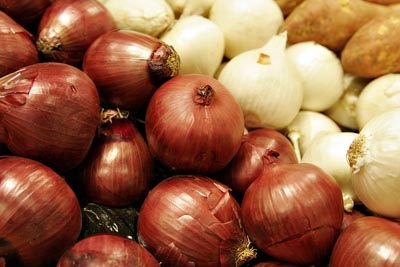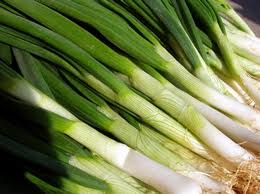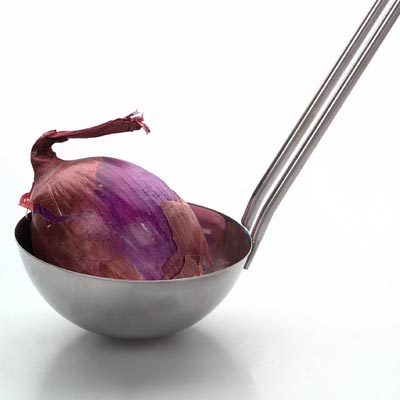Know Your Onions
For me, the smell of chopped onions gently frying in oil is one of the great cooking smells.
 No matter where I am, this warm enticing smell is instantly recognisable and very inviting. Indeed, where would chefs and cooks be without onions?
In her book O, For An Onion, Denise Greig points out that the onion is the most commonly used flavouring vegetable in the world. It is hard to think of a meal which doesn’t include this versatile vegetable. Stir-fries, soups, pastas, casseroles, pies, tarts and roasts wouldn’t taste the same without it.It can, however, be a tricky thing “to know one’s onions”. Not just metaphorically (knowing one’s onions means to know one’s job thoroughly) but scientifically.
When you consider that there are 450 known species, you begin to appreciate the difficulty.
Then there’s the problem of different common names given to onions and the fact that these vary from state to state. Take green onions which are variously called scallions (by the Americans), shallots (in Australia) and even spring onions (in Asian cookbooks).
No matter where I am, this warm enticing smell is instantly recognisable and very inviting. Indeed, where would chefs and cooks be without onions?
In her book O, For An Onion, Denise Greig points out that the onion is the most commonly used flavouring vegetable in the world. It is hard to think of a meal which doesn’t include this versatile vegetable. Stir-fries, soups, pastas, casseroles, pies, tarts and roasts wouldn’t taste the same without it.It can, however, be a tricky thing “to know one’s onions”. Not just metaphorically (knowing one’s onions means to know one’s job thoroughly) but scientifically.
When you consider that there are 450 known species, you begin to appreciate the difficulty.
Then there’s the problem of different common names given to onions and the fact that these vary from state to state. Take green onions which are variously called scallions (by the Americans), shallots (in Australia) and even spring onions (in Asian cookbooks).
 These are those long green immature onions with the pungent green tops, evenly slim from root to top and are, to be strictly correct, Japanese bunching onions (‘Allium fistulosum’). They have many uses: try them chopped and added to omelettes, scattered over clear Asian-style soups, added to fried rice and noodle dishes, with Peking Duck, in salads and tarts or julienned and used as a garnish for steamed Chinese-style fish.The difference between these and the true spring onion is that the latter form a white shiny bulb.
Spring onions (those with the bulb) are also good eaten raw, thinly sliced in salads. They’re also good caramelised (slice or quarter them then cook slowly in oil, butter, a little sugar and a splash of sherry vinegar ) and served with roast lamb or beef.
These are those long green immature onions with the pungent green tops, evenly slim from root to top and are, to be strictly correct, Japanese bunching onions (‘Allium fistulosum’). They have many uses: try them chopped and added to omelettes, scattered over clear Asian-style soups, added to fried rice and noodle dishes, with Peking Duck, in salads and tarts or julienned and used as a garnish for steamed Chinese-style fish.The difference between these and the true spring onion is that the latter form a white shiny bulb.
Spring onions (those with the bulb) are also good eaten raw, thinly sliced in salads. They’re also good caramelised (slice or quarter them then cook slowly in oil, butter, a little sugar and a splash of sherry vinegar ) and served with roast lamb or beef.
 Then there are the dry onions – the brown, white, red and large sweet yellow – which are left longer in the ground, producing tough skins for longer storage. They vary in pungency.
Some people even eat the large sweet yellows like apples – but try them first in a rare roast beef sandwich with mustard.White onions are generally more pungent than brown onions and it is good to note that the more pungent the onion is raw, the sweeter it becomes when cooked. Long slow caramelisation is essential as the base for French onion soup and onion tarts and to add depth of flavour to stews and casseroles. Peel white onions under running water to offset watery eyes.
Red onions are excellent in salads because they are sweet and juicy. They’re also good roasted or sliced and uses as a garnish.
And we mustn’t forget the eschalot, or true shallot, beloved by the French – these small brown-skinned bulbs lend fabulous depth of flavour to sauces and are great with game. Try poaching them whole in white wine, then caramelising them. They can be fiddly to peel, but if you pour boiling water over them and leave the for a few minutes, they will be easier to peel.
Then there are the dry onions – the brown, white, red and large sweet yellow – which are left longer in the ground, producing tough skins for longer storage. They vary in pungency.
Some people even eat the large sweet yellows like apples – but try them first in a rare roast beef sandwich with mustard.White onions are generally more pungent than brown onions and it is good to note that the more pungent the onion is raw, the sweeter it becomes when cooked. Long slow caramelisation is essential as the base for French onion soup and onion tarts and to add depth of flavour to stews and casseroles. Peel white onions under running water to offset watery eyes.
Red onions are excellent in salads because they are sweet and juicy. They’re also good roasted or sliced and uses as a garnish.
And we mustn’t forget the eschalot, or true shallot, beloved by the French – these small brown-skinned bulbs lend fabulous depth of flavour to sauces and are great with game. Try poaching them whole in white wine, then caramelising them. They can be fiddly to peel, but if you pour boiling water over them and leave the for a few minutes, they will be easier to peel.

Brown and White Onions

Green onions

Red Onion
